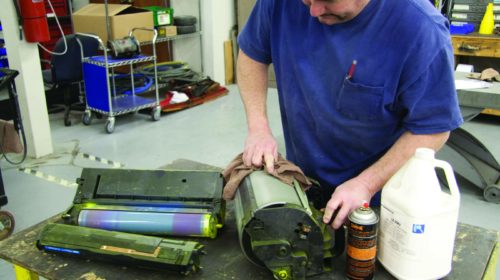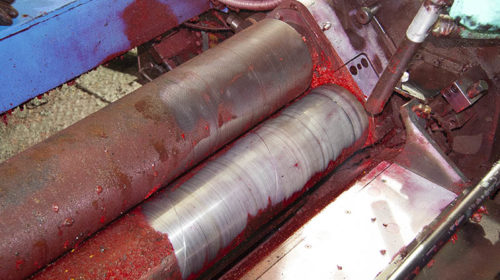
Dry ice blasting improves printing quality while reducing downtime and scrap
THE SITUATION
No matter the size or focus of a printing operation, quality is of the utmost importance. Projects must be delivered by the deadline without printing or color errors. Cleaning and maintenance procedures must be in place to ensure that the printing press functions properly and the operation consistently produces a quality product.
Build-up of ink and grease on printing machinery can cause misalignment and machine malfunction, which results in high scrap rates, lower quality and reduced production. Clogging of vent slots and material build-up on other components can also result in reduced print speed. Printing with fluid inks at high speeds creates an “ink mist” of fine droplets that comes from the transfer of the inks from the printing plate to the surface being printed on. These droplets settle on the printing deck and eventually clog the vent slots or nozzles. This results in a reduced and uneven airflow, which in turn inhibits proper drying. To compensate for this reduced airflow, the press speed is reduced.
THE PROBLEM
In many printing facilities, machinery is not cleaned until absolutely necessary to avoid lengthy downtime. The traditional method of manually cleaning is time consuming, stalls production and does not completely remove inks, grease and paper grime from the equipment.
Manual cleaning often involves scraping and wiping with chemical solvents and wire brushes. This can damage the sensitive parts of the machinery. It also is very labor intensive and the chemicals used can harm the employees conducting the cleaning.
Typically, several hours are spent on each color station to scrape and wipe the critical surfaces. With today’s modern presses having six to eight color decks, cleaning downtime can easily add up to several thousands of dollars of lost production per cleaning cycle.
THE SOLUTION
Dry ice cleaning is an ideal cleaning solution for many different types of printing presses, including off set, flexography and Gravure. The process can easily clean any part of the press, such as the rollers, drums, ink trays, side frames and the feeder/delivery unit.
Dry ice cleaning is an air-powered media blasting system which uses solid carbon dioxide (CO2) in place of walnut shells or other particulate material. Unlike the other blasting techniques, dry ice sublimates (converts from solid to gas) upon impact with the surface being cleaned, leaving no residue behind other than what was removed from the cleaning process. This results in a cleaning technique that is safe and non-toxic, does not create downstream contamination and reduces or eliminates exposure to dangerous chemical cleaning agents.
THE RESULT
Dry ice cleaning quickly cleans the press and its components in place, without generating secondary waste and with little to no disassembly required. The rollers on the printing press can be removed, which provides easy access to all surfaces. Both sides of the deck can be cleaned in as little as 10-15 minutes before going back into production. In a typical cleaning process, manual scraping requires 20-30 hours per piece of equipment. Using the Cold Jet dry ice cleaning process, the same piece of equipment is cleaned in less than two hours. A 56 inch six to seven color printing press takes nearly 90 minutes to clean with the traditional method. When cleaning with dry ice, it takes only 30 minutes.
“We like our Cold Jet very well,” said a department supervisor at a commercial printing facility. “It makes life much easier in helping the equipment stay in better condition. The ease of operation and amount of cleaning we get done is amazing. It cleans a 56 inch press in just 30 minutes, and takes grime and glue off with an incredible speed. To see it first hand is really phenomenal.”
It also replaces the use of dangerous solvents, scrapers and chisels and reduces many direct and indirect costs such as downtime, poor printing quality, scrap, wear of machined parts, hazardous waste and solvents.
With this type of speed and efficiency, there is no longer a need to wait for the next shutdown to clean. It is cost effective to do cleaning between jobs, which results in increased production and extended product life.

